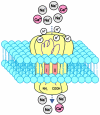Acid-sensing ion channels (ASICs) as pharmacological targets for neurodegenerative diseases
- PMID: 17945532
- PMCID: PMC2267925
- DOI: 10.1016/j.coph.2007.09.001
Acid-sensing ion channels (ASICs) as pharmacological targets for neurodegenerative diseases
Abstract
A significant drop of tissue pH or acidosis is a common feature of acute neurological conditions such as ischemic stroke, brain trauma, and epileptic seizures. Acid-sensing ion channels, or ASICs, are proton-gated cation channels widely expressed in peripheral sensory neurons and in the neurons of the central nervous system. Recent studies have demonstrated that activation of these channels by protons plays an important role in a variety of physiological and pathological processes such as nociception, mechanosensation, synaptic plasticity, and acidosis-mediated neuronal injury. This review provides an overview of the recent advance in electrophysiological, pharmacological characterization of ASICs, and their role in neurological diseases. Therapeutic potential of current available ASIC inhibitors is discussed.
Figures




References
-
- Chesler M. The regulation and modulation of pH in the nervous system. Prog Neurobiol. 1990;34:401–427. - PubMed
-
- Rehncrona S. Brain acidosis. Ann Emerg Med. 1985;14:770–776. - PubMed
-
- Chesler M, Kaila K. Modulation of pH by neuronal activity. Trends Neurosci. 1992;15:396–402. - PubMed
-
- Siesjo BK. Acidosis and ischemic brain damage. Neurochem Pathol. 1988;9:31–88. - PubMed
-
- Kaku DA, Giffard RG, Choi DW. Neuroprotective effects of glutamate antagonists and extracellular acidity. Science. 1993;260:1516–1518. - PubMed
Publication types
MeSH terms
Substances
Grants and funding
LinkOut - more resources
Full Text Sources
Other Literature Sources
Medical

